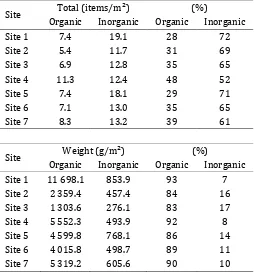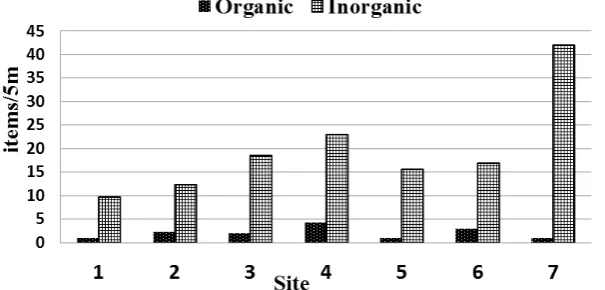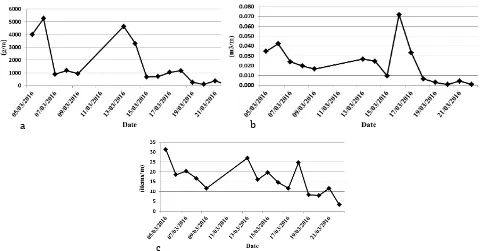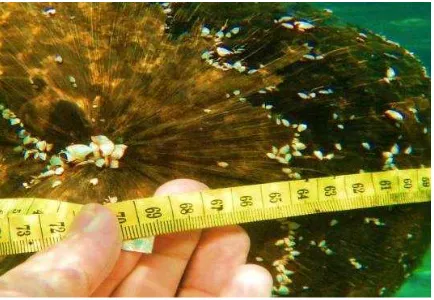Daily Accumulation and Impacts of Marine Litter on The
Shores of Selayar Island Coast, South Sulawesi
Roni Hermawan
1, Ario Damar
2, Sigid Hariyadi
21Post-graduate Student of Coastal and Marine Resources Management, FPIK-IPB, 16680, Bogor
2Departement of Aquatic Resources Management, FPIK-IPB, 16680, Bogor e-mail: hermawanrooney@gmail.com
Abstract - West coast of Selayar facing solid marine litter during west monsoon period December until March, marine litter come from floating litter, carried by sea surface current and deposited along the west coast. Marine litter deposited on the west coast affected social, economic and ecological. This study aims to determine type, weight, density and distribution of marine litter; the impact of litter on water quality; the impact of economic, social and environmental ecosystems. Retrieved data using line transect at 7 observation points. Litter size were observed (> 2.5 cm) or macro litter. Floating litter and daily incresing of litters were also analyzed. Inorganic waste density is 14.3 ± 2.97 items/m2 for the number of pieces and 564.8 ± 196.1 g/m2 for
waste weight. Daily accumulation was about 1 445 ± 1 743 g/m/day, the number of pieces 14.3 ± 8 item/m/day, cubication 0.0187 ± 0.019 m3/m/day. The impacts on seagrass and biota such as broken leaves, crushed and organism rafting on floating
litter some types of coral such as Favia fragum, types of crustaceans such as Balanus. sp, Lepas. sp, Dosima. sp which affect the bio-diversity.
Keywords– marine litter, Selayar island, management, impact, ecology.
Submission: March 2, 2017 Correction: April 12, 2017 Accepted: April 20, 2017
Doi: http://dx.doi.org/10.12777/wastech.5.1.15-20
[How to cite this article: Hermawan, R., Damar, A., Hariyadi, S. (2017). Daily Accumulation and Impacts of Marine Litter on The Shores of Selayar Island Coast, South Sulawesi. Waste Technology, 5(1), 15-20. doi:http://dx.doi.org/10.12777/wastech.5.1.15-20]
1. Introduction
Selayar island is an island of Selayar Islands, South Sulawesi. Facing directly with the Java sea, Selayar island is dependent on seasonal winds and currents. West monsoon periods from December to March, East monsoon between May and August and transition periods of April until the middle of May and half of September to November but it is very difficult to predict the seasons (Bandiyono et al., 2007; BPS, 2015; Krishnamurthy and Kinter, 2003). The wind drives surface currents carry floating litter(Choy and Drazen, 2013; Vikas and Dwarakish, 2015). According to (Critchell et al., 2015; Critchell and Lambrechts, 2016) wind and surface currents greatly affect to litter distribution at the sea. During west monsoon floating litter drive towards Selayar island west coast, and stranded at beach and affect of social, economic and ecologic. This research observed these phenomena scientifically.
Many researches in Indonesia recorded on the beach and river litter in Palu, Central Sulawesi (Walalangi, 2012), marine litter in the Thousand islands and the Ambon (Uneputty and Evans, 1997a; Uneputty and Evans, 1997b), on seagrass (Mandasari, 2004) and plastic debris (Jambeck et al., 2015; Sherman and Sebille, 2016; Willoughby et al., 1997).
Impacts of marine litter on Indonesia less in data. This research aims to determine the composition and density of beach litter; to determine daily rate of increase of marine litter; the impacts of marine litter against the ecology on Selayar island west coast.
2. Materials and Methods
Research location shown in Figure 1. This research was conducted in February to March 2016. The point of observation represented at 7 monitoring site by the character of coastal. On Figure 1 shows the length of the beach and the observation site.
litter were taken and sorted, then analyzed the amount, types, weights, density and composition of marine litter (Eriksson et al., 2013; Walalangi, 2012)
Figure 1. Point Site Research Map
3. Results and discussion 3.1 General conditions
Selayar island from north to south about 108 km, facing directly the Java Sea in the west and the Makassar Strait in the north have a direct impact on ocean currents from the west monsoon. The west monsoon drives the current surface and carries floating materials to Selayar island west coast. West monsoon caused by high air pressure in Asia and low pressure in Australia, the wind carrying moist air during December to March become the rainy season in Indonesia(Aprilleria et al., 2015).
3.2 Wind Drive and Ocean Surface Currents
Ocean surface current influenced by the direction and strength of wind drive (Lei et al. 2000). Based on data obtained from (Wyrtki, 1961; Balitbang KP , 2016; ECMWF, 2016). Wind patterns and currents took in December 2015 to April 2016 to describe wind patterns and currents at the time of the season. Wind
drive and surface currents analyzed
for determine floating litter movement around the Selayar island during west monsoon.
Based on wind drive on December from the Java Sea toward south Sulawesi and several small islands, wind drive on Selayar island ranged from 0.03 to 1.55 m s-1. The movement of the wind also occurs from the
direction of the Makassar Strait and the island of Kalimantan, head South Sulawesi island and the island of Selayar at speeds between 1.56 to 2.65 m s-1. In wind speed average in Selayar Island between 3.05 till 5.57 m s-1 moves from the Banda Sea to the Java Sea,
direction or moving from East to West, the island of Selayar island of Selayar. Based on (Goldberg, 1997) surface current in December of the current air speed between 0.25 to 0.38 m s-1 from the Java Sea and the
Makassar Strait to the South Sulawesi, surface current speed in February increased from 0.38 to 0.75 m s-1 in
the south Sulawesi including Selayar Islands, in April the movement flow began turn over to the Java Sea from the Banda Sea at speeds of 0.25 m s-1 is the start
of east monsoon season or transition period.
3.3 Density of Marine Litter
The composition of marine litter were divided into two categories organic litter and inorganic litter. Based on the average numbers of marine litter compared to organic and inorganic. By weight, organic more than inorganic (Table 1 and 2). Inorganic litter lighter than organic litter because most of the inorganic litter materials are plastic, styrofoam and rubber that lighter material than organic litter.
Table 1. Density of Marine Litter by Amount (items/m2) and by Weight (g/m2).
Site Total (items/m²) (%)
Organic Inorganic Organic Inorganic
Site 1 7.4 19.1 28 72
Organic Inorganic Organic Inorganic
The highest of amount distribution organic litter pieces on 4 site which were the estuaries. The high number of the inorganic litter pieces at 1site and 5 site, at 5 site had sloping shore so marine litter easily stranded. The local communities utilize litter wood for household scale blacksmith so the amount of organic
litter low number at the 5 site. The highest of distribution organic and inorganic litter cubication at the 7 site. Organic litter at the 7 site was dominated by a large wood timber, inorganic litter in the 7 site was dominated by bottles and rubber sandals by cubication.
Figure 2 (a) (b) Spread of Marine Litter by Amount; (c) (d) by Weight; (e) (f) Spread by Cubication
3.5 Composition, Density and Distribution of Floating Marine Litter
Based on floating litter observation (Figure 3) spread unevenly, the larger number on intertidal area. The highest amount was on the 7 site about 42 items/5m for inorganic litter. Site 7 with length of beach to slope was 302 m and facing the sea directly so floating litter larger on this site. Plastic litter was dominating the inorganic litter especially plastic bag or plastic wrapper. Plastic litter was lightweight, strong, durable and corrosion resistant, mainly used as wrapping food. The food product is very dependent
on the quality of wrapper, so the manufacturers improve quality of plastic wrapper. On seagrass ecosystem was not found litter on seagrass ecosystems, except near the intertidal area. March was the end of west monsoon, water currents and wind drive were not too strong, floating litter become decrease. The composition of floating litter was dominated by timber, coconut and plastic litter.
3.6 Daily Accumulation of Marine Litter
Daily accumulation of marine litter determine at the
a b c d
beach with counting and weighing the stranded beach litter for 17 days from 5 to 22 March 2016. Based on the observations, the litter consists timber, plastic cups, plastic wrap, styrofoam, rubber sandals and plastic bottles. Based on the calculation of weights,
numbers and cubication were analyzed
in graph (Figure 4a, b and c). Daily increase of marine litter decline due to water currents and wind speeds toward the end of March, which lower the speed wind and current. The number of stranded marine litter
decreased over a slowdown of sea water current, thus daily increasing litter was getting lower. Late March or early April was the transition period (Realino et al., 2006). A transitional season was marked by a decrease of seawater current and wind speed, it was usually coastal waves become calm. Based on the calculation of average daily increase by weight about 1 445 ± 1 743 g/m/day, the number of pieces of 14.3 ± 8 item/m/day, cubication 0.0187 ± 0.019 m3/m/day.
Fig. 4 Daily Increase of Marine Litter by (a) Weight; (b) Cubication; (c) Amount
3.7 Marine Litter impact to Ecosystems and Biotic Impact on the ecology in the waters especially in the intertidal, the impact arising from floating litter that stranded in the intertidal area. Litter piled up on the beach, covering the seagrass and organism, covered by plastic wrap, timber and glass bottles. Plastic wrappers and timber lots in the area found on the intertidal. Some of timbers and floating materials were sinks in the intertidal area. During low tide floating materials were covered and pilled up on vegetation or organism. Impact on seagrass and organism that are covered and pilled up such as broken leaves, tissue abrasion causing partial or mortality. Effected and broken seagrass leaves become litter and washed away by water current to the beach. The damaged seagrass leaves and accumulate along the coast, on observations at sites 1, 2 and 4 of seagrass leaves litter weight about 2.68 to 23.6 kgs.
There was a sea cucumber that associated with plastic bag, some types of plastic litter will sink to the
sea bottom of the waters and rotted or overgrown with algae. Pelagic plastic debris is ideally suited for rafting due to its abundance, buoyancy, and persistence, and has rapidly become a common substrate (Goldstein, 2012). Some organism were attracted by marine litter that float or sink in the water. They seek shelter so using litter for association. Some biota such as fish, crustaceans, mollusk and others used plastic litter as a new substrate habitat(Gall and Thompson, 2015). According to (Allsopp et al., 2006) that plastic litter covered more than 50% would affect the foraging ability of Gastropods. Some of stranded marine litter had associated by multiple types of coral Favia fragum, kind of like crustaceans such as Balanus sp and Lepas
sp (Figure 5). Associated with coconuts, glass bottles, plastic bottles, plastic wrap, bouy, nets, ropes and timber. Some marine organism used floating marine litter for rafting (Bergmann et al., 2015) Wright et al. 2013). Uncontrolled dispersion due to ocean currents.
a
b
Fig. 5 Lepas sp. associated with floating coconut litter
According to (Kiessling et al., 2015) who have reviewed 82 scientific publications stating that there were 387 species using marine litter as a media to migrate (rafting), where 244 species have been identified and 143 taxa. Invasive species can be a major impact to sea ecosystem and biodiversity (Grassle et al., 1991). This biotic mixing is becoming a widespread problem due to human activities, and it is a potential threat to native marine biodiversity. According to some studies estimate, the diversity of species decreased to 58% if there is a mixing biota in the whole world (McKinney, 1998). activities, threat biodiversity by increase rafting of invasive species.
References
Allsopp M, Walters A, Santillo D, Johnston P. 2006. Plastic Debris in
the World ’ s Oceans. Greenpeace Report. .[Retrieved on March
2016]
www.greenpeace.org/international/en/publications/reports/pl astic_ocean_report/
Aprilleria V, Meidiana M, Karina S I. 2015. The influence of monsoon in Indonesia as arenewable energy source and sustainable development. Proceedings of 23rd TheIIER International Conference, Singapore.
Badan Pusat Statistik (BPS). 2015. Statistik daerah kabupaten Kepulauan Selayar 2015. Badan Pusat Statistik Kabupaten Kepulauan Selayar. Makassar.
[Balitbang KP] Badan Penelitian dan Pengembangan Sumber Daya Laut dan Pesisir. 2016. Data Perairan Indonesia. [Retrieved on February 2016] www.p3sdlp.litbang.kkp.go.id
Bandiyono S, Ngadi, Imron M, Soetopo T. 2007. Kondisi Sosial-Ekonomi Masyarakat di Lokasi COREMAP II (Kasus Kabupaten Selayar). CRITC-LIPI. COREMAP-LIPI.
Bergmann M, Gutow L, Klages M. 2015. Marine Anthropogenic Litter. Springer International Publishing AG Switzerland Springer
Science. Business Media. Spinger Open.
Choy C, Drazen J. 2013. Plastic for dinner? Observations of frequent debris ingestion by pelagic predatory fishes from the central
North Pacific. Marine Ecology Progress Series. Vol. 485: 155–163, 2013 doi: 10.3354/meps10342
Critchell K, Grech A, Schlaefer J, Andutta FP, Lambrechts J, Wolanski E. 2015. Estuarine , Coastal and Shelf Science Modelling the fate of marine debris along a complex shoreline : Lessons from the Great Barrier Reef. Estuarine,Coastal and Shelf Science. 1–13. Critchell K, Lambrechts J. 2016. Estuarine , Coastal and Shelf Science
Modelling accumulation of marine plastics in the coastal zone ;
what are the dominant physical processes ? Estuarine, Coastal and Shelf Science. 171, 111–122.
Eriksson C, Burton H, Fitch S, Schulz M, Hoff J Van Den. 2013. Daily Accumulation Rates of Marine Debris on sub-Antarctic Island Beaches. Marine Pollution Bulletin, 66(1–2), 199–208.
[ECMWF] European Centre for Medium-Range Weather Forecasts. 2016. [Retrieved on February 2016] http://www.ecmwf.int/. Gall SC, Thompson RC. 2015. The impact of debris on marine life.
Marine Pollution Bulletin. 92(1–2), 170–179.
Goldstein, M. C. 2012. Abundance and ecological implications of microplastic debris in the North Pacific Subtropical Gyre, 224pp Goldberg ED. 1997. Plasticizing the Seafloor: An Overview.
Environmental Technology. 18:2, 195-201.
Grassle JF, Lassere P, McIntyre AD, Ray GC. 1991. Marine biodiversity and ecosystem function. Biology International Special Issue 23, 1–19.
Jambeck JR, Geyer R, Wilcox C, Siegler T R, Perryman M, Andrady A, Narayan R, Law K L. 2015. Plastic Waste Inputs from Land into The Ocean. Marine Pollution. Science. VOL 347 ISSUE 6223. American Association for the Advancement of Science (AAAS) Krishnamurthy V, Kinter JL. 2003. The Indian monsoon and
Relation to Global Climate Variability. Global Climate. Springer-verlag.
Kiessling T, Gutow L, Thiel M. 2015. Marine Litter as Habitat and Dispersal Vector; Marine Anthropogenic Litter, Springer International Publishing AG Switzerland Springer Science.
Business Media. Spinger.
Lippiatt S, Opfer S, Arthur C. 2013. Marine Debris Monitoring and Assessment. NOAA Technical Memorandum NOS-ORdanR-462005. [Retrieved on October 2015]
http://marinedebris.noaa.gov/sites/default/files/Lippiatt_et_al_ 2013.pdf
Mandasari M AR. 2014. Hubungan Kondisi Padang Lamun dengan Sampah Laut di Pulau Barranglompo. Makassar (ID): Universitas Hasanuddin
McKinney R.L. 1998. On Predictingbiotic Homogenization––species- Area Patterns in Marine Biota. Global Ecology and Biogeography Letters 7, 297–301
Realino B, Teja A, Wibawa, Dedy A, Zahrudin, Asmi M N. 2006. Pola Spasial dan Temporal Kesuburan Perairan Permukaan Laut di Indonesia. Balai Riset dan Observasi Kelautan, Badan Riset Kelautan dan Perikanan, Bali (ID): Departemen Kelautan dan Perikanan Jembrana Bali. 54pp.
Sherman, P. Sebille, E. 2016. Modeling marine surface microplastic transport to assess optimal removal locations. IOP Publishing. Environ. Res. Lett. 11 (2016) 014006.
[UNEP] United Nations Environmental Programme. 2009. Guidelines on Survey and Monitoring of Marine Litter. Regional Seas Reports and studies No. 186 IOC Technical Series No. 83. United Nations Environment Programme / Intergovernmental Oceanographic Commission
Uneputty, P. A., Evans, S. M. 1997a. Accumulation of Beach Litter on Islands of the Pulau Seribu Archipelago, Indonesia. Elsevier.
Marine Pollution Bulletin, Vol. 34, No. 8, pp. 652-655.
Uneputty, P., Evans, S.M. 1997b. The Impact of Plastic Debris on the Biota of Tidal Flats in Ambon Bay (Eastern Indonesia). Marine Environmental Research 44 (3): 233-242
Vikas M, Dwarakish GS. 2015. Coastal Pollution : A Review. Aquatic Procedia, 4 (Icwrcoe), 381–388.
Willoughby, N. G., Sangkoyo, H., Lakaseru, B. O. 1997. Beach litter: an increasing and changing problem for Indonesia. Elsevier.Marine Pollution Bulletin. 34: 469–478
Wright SL, Thompson RC, Galloway TS. 2013. The physical impacts
of microplastics on marine organisms : A review. Environmental Pollution, 178, 483–492



